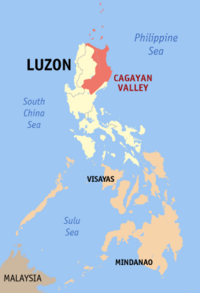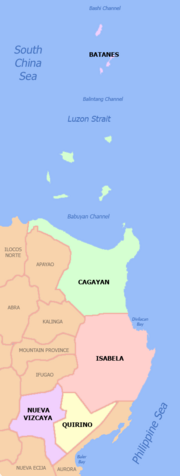Cagayan Valley
 |
|
| Regional center | Tuguegarao City |
|---|---|
| Population | 2,813,159 |
| – Density | 104.8 per km² |
| Area | 26,837.0 km² |
| Divisions | |
| – Provinces | 5 |
| – Cities | 4 |
| – Municipalities | 89 |
| – Barangays | 2,311 |
| – Cong. districts | 10 |
| Languages | Ilokano, Ibanag, Ivatan, Itawis, Gaddang, others |
Cagayan Valley (Lambak ng Cagayan in Filipino) is a region of the Philippines, also designated as Region II or Region 02. It is composed of five provinces, namely: Batanes, Cagayan, Isabela, Nueva Vizcaya, and Quirino. Its regional center is Tuguegarao City.
Most of the region lies in a large valley in northeastern Luzon, between the Cordilleras and the Sierra Madre mountain ranges. Cagayan River, the country's longest river runs through its center and flows out to Luzon Strait in the north, in the town of Aparri, Cagayan. The Babuyan and Batanes island groups that lie in the Luzon Strait also belong to the region.
Contents |
Economy
The Cagayan Valley Region is defined by the Cagayan River, the largest in the Philippines. The Province of Cagayan occupies the lower course of the river, and the northeast corner of the island of Luzon (with a few offshore islets). Cagayan's area is 9,003 km²., its population 952,000 (by the 2000 census) in twenty-nine towns, of which Tuguegarao is the capital.
Archaeology indicates that the Cagayan Valley has been inhabited for half a million years, though no human remains of any such antiquity have yet appeared. The earliest inhabitants are the Agta, or Atta, food-gatherers who roam the forests without fixed abode. A large tract of land has lately been returned to them. The bulk of the population are of Malay origin. For centuries before the coming of the Spanish the inhabitants traded with Indians, Malays, Chinese, and Japanese. In the nineteenth century the prosperity found in tobacco cultivation caused many Ilocanos to settle here. Tobacco is still a major factor in the economy of Cagayan, though a special economic zone and free port has been created to strengthen and diversify the provincial economy. Cagayan has much to offer visitors: beaches, swimming, snorkeling, skin-diving, fishing in the river and the sea, hiking in primeval forest, mountain-climbing, archaeological sites, the remarkable collection of the provincial museum, the Callao Caves, and many fine churches. Even here there are fortifications built to protect the inhabitants from raids by the Moros
The Philippine Republic's Region II, Cagayan Valley, contains two landlocked provinces, Quirino and Nueva Vizcaya. Both are relatively small in size (3057 km2 for Quirino, 4081 km2 for Nueva Vizcaya) and population (147,000 and 365,000, respectively, by the 2000 census). Both are ruggedly mountainous and heavily forested. Nueva Vizcaya is the remnant of the southern province created when Cagayan Province was divided in two in 1839. Both are ethnically and linguistically diverse, with a substrate of Agtas, Negritos who are food-gatherers with no fixed abode, overlaid by Ilonggos and others in a number of tribes, some of whom were fierce head-hunters (we are firmly assured that they have given up the practice), with the latest but largest element of the population being Ilocanos. Nueva Vizcaya comprises fifteen towns; Bayombong is the capital. Agriculture in both has until recently consisted of slash-and-burn cultivation of corn and maize, though more stable cultivation of vegetables and fruits is becoming established. Both also produce logs, and are trying to manage their forest resources so that production can be sustained indefinitely. They have deposits of gold, silver, copper, iron. Nueva Vizcaya has sand and clay.
At Balete Pass in Nueva Vizcaya the retreating Japanese under General Tomoyuki Yamashita dug in and held on for three months against the American and Filipino forces who eventually drove them out; the pass is now called Dalton Pass in honor of General Dalton, USA, who was killed in the fighting.
Nueva Vizcaya was probably named after Vizcaya (English: Biscay, Basque: Bizkaia) province in northern Spain. In this case there is some vexillological relationship between them, as the flag of New Biscay bears the arms of Biscay impaled on its seal.
Tilapia capital of the Philippines

On January 11, 2008, the Cagayan Bureau of Fisheries and Aquatic Resources (BFAR) stated that tilapia (species of cichlid fishes from the tilapiine cichlid tribe) production grew and Cagayan Valley is now the Philippines’ tilapia capital (Saint Peter’s fish). Production supply grew 37.25% since 2003, with 14,000 metric tons (MT) in 2007. The recent aquaculture congress found that the growth of tilapia production was due to government interventions: provision of fast-growing species, accreditation of private hatcheries to ensure supply of quality fingerlings, establishment of demonstration farms, providing free fingerlings to newly constructed fishponds, and the dissemination of tilapia to Nueva Vizcaya (in Diadi town). Former cycling champion Lupo Alava is a multi-awarded tilapia raiser in Bagabag, Nueva Vizcaya. Chairman Thompson Lantion of the Land Transportation Franchising and Regulatory Board, a retired two-star police general, has fishponds in La Torre, Bayombong, Nueva Vizcaya. Also, Nueva Vizcaya Gov. Luisa Lloren Cuaresma also entered into similar aquaculture endeavors in addition to tilapia production.[1]
Political Divisions

| Province/City | Capital | Population (2000) |
Area (km²) |
Pop. density (per km²) |
|---|---|---|---|---|
| Batanes | Basco | 16,467 | 209.3 | 78.7 |
| Cagayan | Tuguegarao City | 993,580 | 9,002.0 | 110.4 |
| Isabela | Ilagan | 1,177,044 | 10,409.6 | 113 |
| Nueva Vizcaya | Bayombong | 366,962 | 3,903.9 | 94.0 |
| Quirino | Cabarroguis | 148,575 | 3,057.2 | 48.6 |
| Santiago City | — | 110,531 | 255 | 433 |
Component Cities
- Cauayan City, Isabela
- Tuguegarao City, Cagayan
Santiago City is an independent component city, figures are excluded from Isabela province.
See also
- Super regions of the Philippines
External links
- Executive Order No. 561: FORMATION OF THE "SUPER" REGIONS AND MANDATE OF THE SUPERREGIONAL DEVELOPMENT CHAMPIONS
- North Luzon Super Region: Potentials
- North Luzon Super Region: Projects
- Ilocano: Ti Pagsasao ti Amianan
- Ilocano Wikipedia
- NAKEM Centennial Conference
References
|
|||||||||||